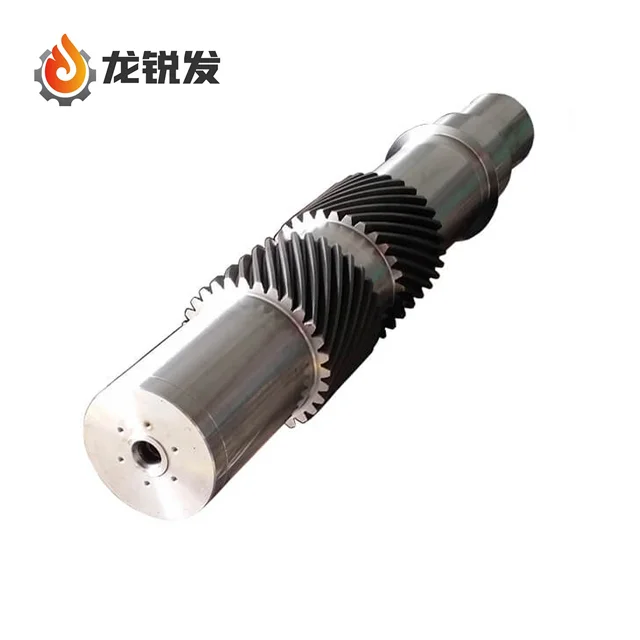The precision automotive gear shaft is a fundamental mechanical component that defines the efficiency, durability, and performance of modern vehicles. As part of a vehicle’s transmission system, it ensures smooth power transfer between the engine and the drive system. By integrating advanced machining and high-strength materials, these shafts deliver accurate torque transmission, stable gear meshing, and long-term operational reliability — all essential for today’s high-performance automotive standards.
In an automotive gearbox, the precision gear shaft is not just a supporting element; it is the core axis of motion that synchronizes multiple gears, balancing rotational speed and torque to optimize driving dynamics and fuel efficiency. Longruifa, a high quality custom industrial gear manufacturer, will share the structural design of precision automotive gear shaft for sale, its manufacturing process, etc.
Structural Design of Automotive Gear Shafts
The design structure of an automotive gear shaft reflects engineering precision and performance optimization. Typically, the shaft features a stepped cylindrical body with multiple sets of helical gears arranged along its length. These gears have a regular tooth profile, designed to reduce noise and vibration while improving load-carrying capacity.
The shaft ends usually incorporate axial holes or keyways for coupling or assembly with other transmission components. Around the shaft body, smaller mounting holes or threads allow for precise connection with bearings, synchronizers, and clutch hubs.
Each section of the shaft is machined to micrometer-level accuracy, ensuring perfect alignment of the gear teeth and minimizing energy loss during transmission. The use of CNC grinding and heat treatment processes further enhances hardness, wear resistance, and dimensional stability.
Manufacturing Process of Precision Gear Shafts
Producing a precision gear shaft for automotive applications involves a series of advanced machining steps and quality control processes. The goal is to achieve tight tolerances, precise surface finishes, and consistent gear profiles. The key stages typically include:
-
Material Selection:
High-grade alloy steels such as 20CrMnTi, 18CrNiMo7-6, or 42CrMo are commonly used. These materials combine excellent toughness with the ability to undergo carburizing or nitriding for enhanced surface hardness. -
Rough and Finish Machining:
Turning, milling, and drilling operations shape the basic shaft geometry, followed by grinding and honing to achieve precise dimensions and surface roughness levels below Ra 0.8 µm. -
Gear Cutting and Grinding:
Helical gears are cut using hobbing machines and then fine-ground for smooth meshing and consistent tooth profiles, ensuring high transmission accuracy. -
Heat Treatment:
Carburizing, quenching, and tempering processes improve the core strength and surface hardness, providing superior fatigue resistance under high torque loads. -
Assembly and Testing:
The finished gear shaft undergoes dynamic balance tests, magnetic particle inspection, and concentricity verification to guarantee quality and durability before being installed in transmission systems.
Functional Importance in Automotive Transmission Systems
The automotive gear shaft’s primary function lies in power transmission, torque conversion, and speed adjustment within the gearbox. It serves as the rotational axis on which multiple gears are mounted and meshed. Through precise engagement, the shaft enables seamless shifting between gear ratios, adapting engine output to road conditions.
In manual transmissions, the gear shaft coordinates gear selection via the clutch and gear lever, allowing drivers to control speed and torque distribution manually. In automatic transmissions, it works alongside hydraulic systems and planetary gears to manage gear changes automatically and smoothly.
A well-engineered gear shaft ensures:
-
Reduced vibration and noise, contributing to driving comfort.
-
Stable torque delivery even under varying loads.
-
Increased transmission lifespan through efficient load distribution.
-
Energy efficiency by minimizing power loss in mechanical transfer.

Applications of Precision Gear Shafts in the Automotive Industry
Precision automotive gear shafts are integral to a wide range of vehicle types and powertrain configurations, including:
-
Passenger Cars: Used in both manual and automatic transmissions for consistent performance and smooth gear shifts.
-
Commercial Trucks and Buses: Designed for high torque transmission and long operational life under heavy-duty conditions.
-
Electric and Hybrid Vehicles: Adapted for compact gear reducers and e-drive units that demand high efficiency and silent operation.
-
Performance and Racing Cars: Engineered for lightweight strength, high rotational speed tolerance, and minimal friction losses.
Beyond the automotive sector, precision gear shafts also find use in industrial gearboxes, agricultural machinery, and aerospace systems, where accuracy and durability are equally critical.
Advances in Gear Shaft Precision Engineering
The evolution of precision gear shaft technology aligns with the broader trend of vehicle electrification, automation, and digital manufacturing. Modern production integrates CNC-controlled machining, finite element analysis (FEA), and laser surface hardening to achieve higher precision and material optimization.
Additionally, digital twin technology allows engineers to simulate torque distribution and stress concentration before production, enhancing reliability and reducing testing time. Additive manufacturing and composite material development are also being explored to reduce shaft weight without compromising strength.
Material Innovation and Surface Engineering for Gear Shafts
Material and surface engineering play a decisive role in the performance of a precision gear shaft. The current industry trend focuses on lightweight but high-strength alloys and advanced surface coatings to combat wear, corrosion, and fatigue.
Techniques such as plasma nitriding, DLC (diamond-like carbon) coating, and shot peening improve the microstructure of the shaft surface, thereby extending its fatigue life and operational stability. These treatments are especially important in high-speed electric vehicles, where transmission components face continuous rotational stress and elevated temperatures.
Quality Assurance and Performance Testing
To meet global automotive standards, every precision automotive gear shaft must undergo comprehensive quality control. Manufacturers conduct multiple non-destructive tests (NDT) and dimensional inspections throughout production.
Typical testing protocols include:
-
Hardness and microstructure analysis after heat treatment.
-
Dynamic balancing to prevent vibration during operation.
-
Runout measurement to ensure axial alignment.
-
Torque and endurance testing to confirm fatigue resistance.
Only after passing these stringent assessments can a gear shaft be approved for integration into high-performance automotive systems.
Driving Efficiency and Reliability Through Precision Engineering
In today’s automotive landscape, precision gear shafts symbolize the intersection of engineering accuracy, material science, and manufacturing innovation. They are not just mechanical components but critical enablers of transmission reliability, vehicle efficiency, and driver comfort.
As vehicles evolve toward electrification and intelligent control, the demand for lightweight, high-precision, and durable gear shafts will continue to grow. Manufacturers investing in advanced machining, quality management, and sustainable materials are shaping the future of automotive transmission systems — one shaft at a time.
www.lrfgears.com
Longruifa

Average Rating